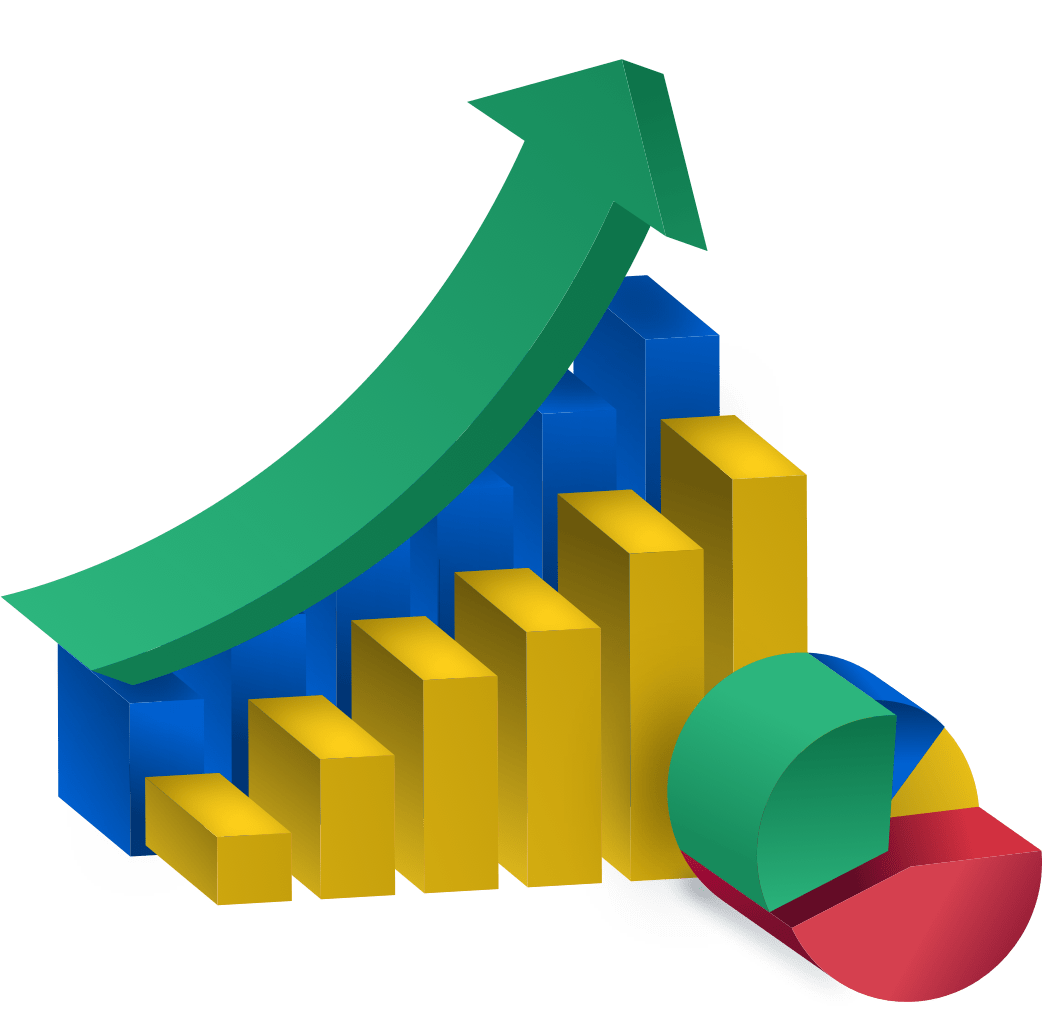Olga Mykhoparkina
Founder, CEO

Olga Mykhoparkina
May 29, 2025SEO is changing faster than ever. It’s not just Google’s bots visiting your site anymore. Now, large language models (LLMs) like ChatGPT and Gemini are reading your content too – and they influence what people see and trust.
This shift is often called AI-first indexing because AI models are starting to decide which content shows up first in answers. If your site isn’t ready for this, you’re missing out on a lot of potential traffic and visibility.
Traditional SEO had a lot to do with keywords, backlinks, and meta tags. This still matters, but it’s not enough. Today, you also need to make sure your content makes sense to machines trained to understand human language. This means clear structure, plain language, and actually answering the questions your future customers are asking.
But don’t panic! In this post, I’ll break down exactly what’s changed, why it matters for your SaaS site, how to get your SaaS brand in ChatGPT answers and–most importantly–how you can structure your web pages to make AI work for you, not against you.
Here are some simple steps you can take right now to get your pages ready for the future of search.
AI-first indexing is Google’s, Bing’s, and other platforms’ way of deciding what gets seen, ranked, or totally ignored, using artificial intelligence. Instead of crawling and indexing every page on the web, search engines now let their AI do a pre-check.
Before your SaaS page even gets a shot, the AI asks: “Is this content actually valuable? Does it answer real user questions? Does it connect to known topics or entities?” If the answer is no, your page might never make it into the search results, no matter how slick your product is. That’s where LLM SEO and LLM optimization come in.
Think about Google’s Search Generative Experience (SGE) or Bing’s integration with GPT. These aren’t giving links to the users but they’re summarizing content, pulling answers from multiple pages, and generating overviews right in the search results. If your content isn’t clear, well-structured, and easy to quote or summarize, it’s going to get skipped over.
Here’s where it gets interesting: AI-first indexing isn’t just “mobile-first” 2.0. With mobile-first, the focus was on how your site looked and loaded on smaller screens. With AI-first, it’s more about how well your content communicates. AI tools need structured, plain-language content that actually says something useful – and they’re trained to detect fluff, keyword stuffing, and vague copy.
Read also: How to get your SaaS brand quoted by ChatGPT (and other AI Tools)
If your homepage, product pages, and blog content are written like sales decks or stuffed with jargon, AI tools are going to struggle. That means fewer mentions in AI answers, less visibility in generative search, and fewer chances to get in front of buyers early.
You need to structure your pages so AI can instantly see what you’re about, how your content connects to real-world concepts (like your product category or pain points you solve), and why your answer is better than the rest.
In short: AI-first indexing forces you to build pages that are both human-friendly and machine-readable, or you’ll get left behind.
Next, let’s break down how they actually read your pages – and what they look for.
So far, we know that AI doesn’t “read” your website like a human does.
It doesn’t get distracted by pretty graphics or clever taglines. It’s not scrolling through your landing page, admiring your clever copy, or filling out your demo form.
Instead, it’s scanning for structure, context, and relationships between ideas. If that’s missing, your SaaS landing page is just a wall of text or a jumble of features. Your page gets ignored, plain and simple.
Related: From Blog Posts to Answers: Repurposing for AI Assistants
In old-school SEO, you had to hit all the right keywords in the right spots. And yeah, that still helps – but it’s not enough. Today’s AI models look at the context around those keywords. They’re asking things like:
That means you need to give them more than just a list of features and a slick tagline.
AI doesn’t just match phrases anymore – it understands entities (like your company, your product, your niche) and how they relate to each other. This is called semantic search, and it’s how tools like ChatGPT or Google’s SGE pull answers.
If your content is vague, jargony, or buried in weird design choices, it gets skipped. If your structure is clear and easy to parse, it becomes usable – and quotable.
Let’s say you run a B2B SaaS product that automates invoice processing.
I’ll take two quick examples to explain my point:
One long, unbroken page with no subheadings, random feature lists, and no clear explanation of what your SaaS actually does. As a result, AI gets confused, misses key info, and your page gets skipped.
Bad structure example
AI looks at that and goes: “No clue what this does. Moving on.”
Clear H1 for your main topic (“All-in-One CRM for SaaS Startups”), H2s for each feature or pain point, bullet lists for benefits, and a FAQ section at the end. As a result, AI can easily scan, extract, and rank the most relevant sections, even if a user’s query is super specific.
Good structure example
Now the AI (and your visitors) know exactly what you offer, who it’s for, and how it helps. That’s the goal.
Learn more: LLMs vs SEO: What’s Changing in Search Discovery
You don’t need to know technical SEO or a fancy plugin to make your web pages work for AI-first indexing. But you do need to get a few basics right – consistently. Here’s what actually matters for AI indexing and semantic search.
Headings aren’t just for breaking up walls of text. They’re the roadmap AI uses to figure out what your page is about, how each section connects, and which web pages to pair with matching search queries. When you use them right, they help AI models and search engines understand what your page is about and how the content flows.
Use H1 for the main idea – usually your page title. Then, use H2s for sections, and H3s for supporting points under each section. This also helps search engine users quickly scan mobile and desktop versions of your site.
Example (SaaS landing page):
H1: “All-in-one payroll software for remote teams”
H2: “Automate global payments”
H2: “Stay compliant in 100+ countries”
H2: “Why finance teams love our product”
H3: “Save time on admin”
H3: “Reduce payment errors”
This kind of layout makes your content easier to scan on both mobile and desktop versions, and easier for AI to pull into answers.
Don’t stop at search rankings — get discovered by AI assistants too. Book a call with Quoleady.
This part’s simple but hard: write clearly. Your content should be easy for real people to read, but also packed with enough context so AI models and search engines understand the topic. Ditch the fluff and get straight to the point.
Machines don’t love fluff. They want direct, useful information. If you can answer a question in two sentences, do that. Think less sales pitch, more helpful explainer. This helps with things like featured snippets and Google’s SGE, where short, specific answers from matching web pages often get pulled in directly.
Bad: “Our platform revolutionizes team synergy to drive operational efficiency.”
Good: “Our tool helps remote teams share files, track tasks, and manage deadlines in one place.”
One sounds like marketing speak. The other sounds like something AI (and real search engine users) can actually use.
Schema markup is a way to give search engines extra info about your content. It’s not visible on the page, but it helps AI understand what’s what. Structured data also signals to semantic search engines how your pages should be indexed.
You don’t need to mark up everything. Just hit the essentials:
Most CMS tools or SEO plugins make adding structured data pretty easy. It’s low effort, high impact, and helps search engines understand the purpose of your web pages.
AI follows your links to understand how your site fits together. Proper internal linking ensures that your mobile version and desktop version of the site is consistent, helping search engines map your content and match search queries to the right web pages.
For instance, your blog talks about “automated expense reporting,” and your product has a feature page for that – link to it. If you’ve written a guide on compliance workflows, link it from your landing page’s “security” section.
Pro tip: Don’t overdo it. Just link where it makes sense, and always use anchor text that’s clear (not “click here”). Correct canonical URL structures and URLs also prevent duplicate content issues and improve page speed, which is critical for mobile device users and mobile first indexing. Avoid keyword stuffing; keep links relevant and context-rich.
Adding these fundamentals helps search engines understand your content, boosts ai indexing, and ensures your mobile version, structured data, and internal linking work together so AI models can better surface your content in semantic search results.
Related: Does Reddit influence LLMs responses? (The 2025 Research)
Okay – so now you know why structure matters and what AI is looking for. But what if your current pages… aren’t exactly AI-friendly?
You don’t need to start from scratch. A few small changes to your page structure, meta tags, and internal linking can make a big difference for both human visitors and AI models. Let’s walk through how to check your site and clean things up – without a full redesign.
If you answered “no” to any of these, don’t panic. That’s normal. Let’s fix it.
You don’t need a developer or a full content overhaul. Here are a few small moves that add up:
Start with these basics: clear structure, logical flow, and helpful links. The easier it is for both AI and human visitors to understand your SaaS, the better your technical SEO results will be.
Your homepage and product pages aren’t just digital brochures anymore. In an AI-first world, they’re often the first thing search engines and AI models see. That means they need to do more than look nic they need to communicate clearly.
Checklist for an AI-friendly homepage:
Example:
Instead of: “The Future of Team Collaboration Starts Here”
Try: “Project management software for remote design teams”
Each product page should answer three questions:
Pro tip: Use headings that sound like real questions:
Add internal links to related features or use cases so both AI and humans can explore your product naturally. This helps your AI-first indexing, improves organic search, and builds topical authority.
Dig deeper: GEO vs SEO: Why Your Content Might Be Invisible in AI Search (And How to Fix It)
It’s one thing to talk about AI-first indexing best practices, but what does it look like in practice? Here are two SaaS brands we’ve worked with at Quoleadythat got real results from structuring their content the right way – for both human visitors and AI models.
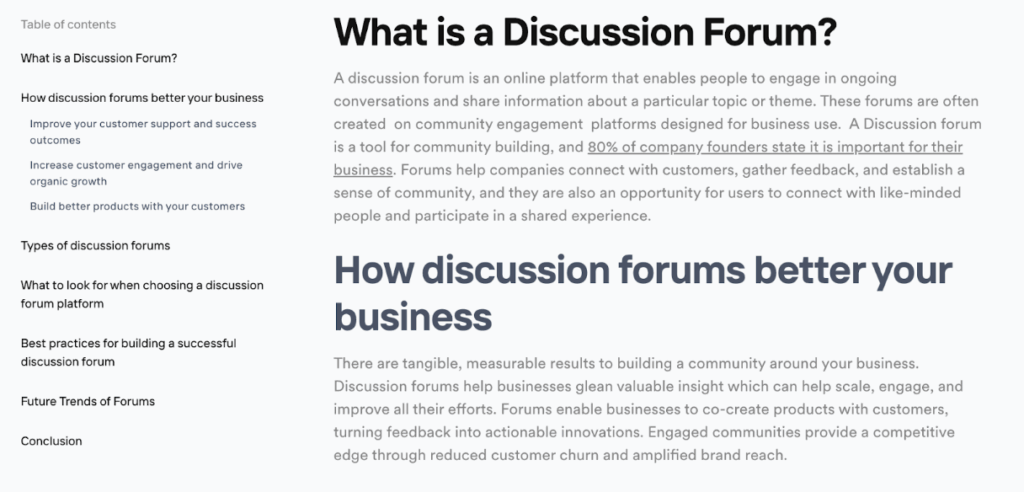
Page: Discussion Forums for Online Communities
Bettermode already had good content, but what we helped them do was refine the page structure for better search engines understand signals. That meant fixing up their headings, making sure each section had a clear purpose, and using H2s and H3s to guide readers (and artificial intelligence systems) through the page.
What we did:
Result: The brand appeared in Google’s search results and Google AI Overview for the keyword “discussion forum examples.” The clean, logical layout made it easier for AI models and people to understand the site’s content, and search engines understand rewarded it in organic search.
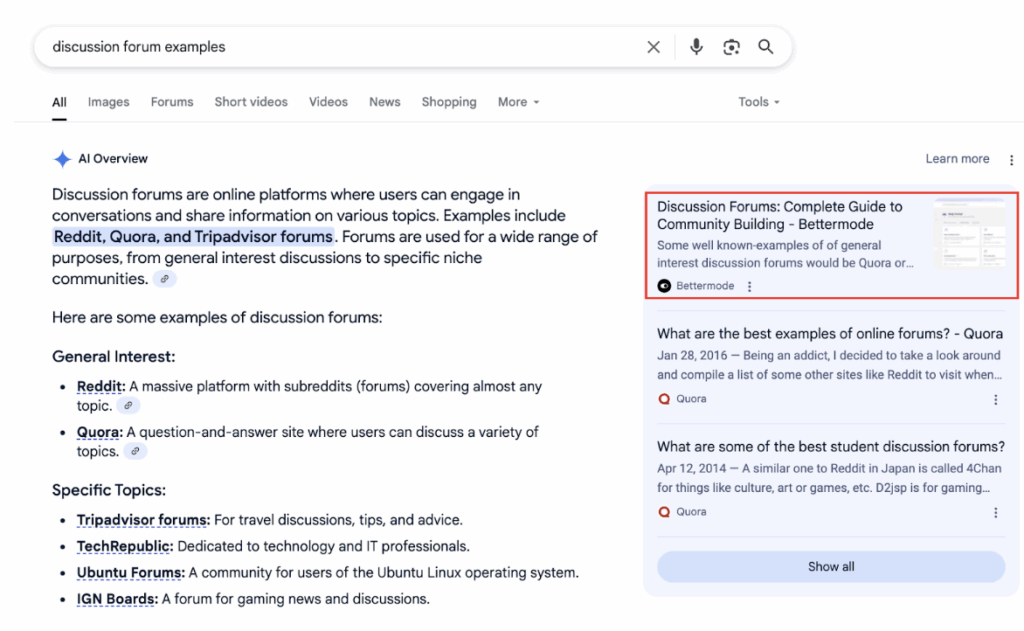
Takeaway: Your heading structure isn’t just about looks. When it reflects what the page actually covers, AI gets it, and so do your users. This is exactly what AI-first optimization is about – making your website’s mobile usability, desktop versions, and mobile version equally strong so search queries lead to relevant pages.

Page: 8 Best AI Forecasting Tools in 2025 (Ranked & Compared)
FuelFinance took things a step further. They wrote a strong, helpful article and then layered in schema markup and strategically structured data to make the content even easier to parse for crawlable AI during the crawling process.
What they did:
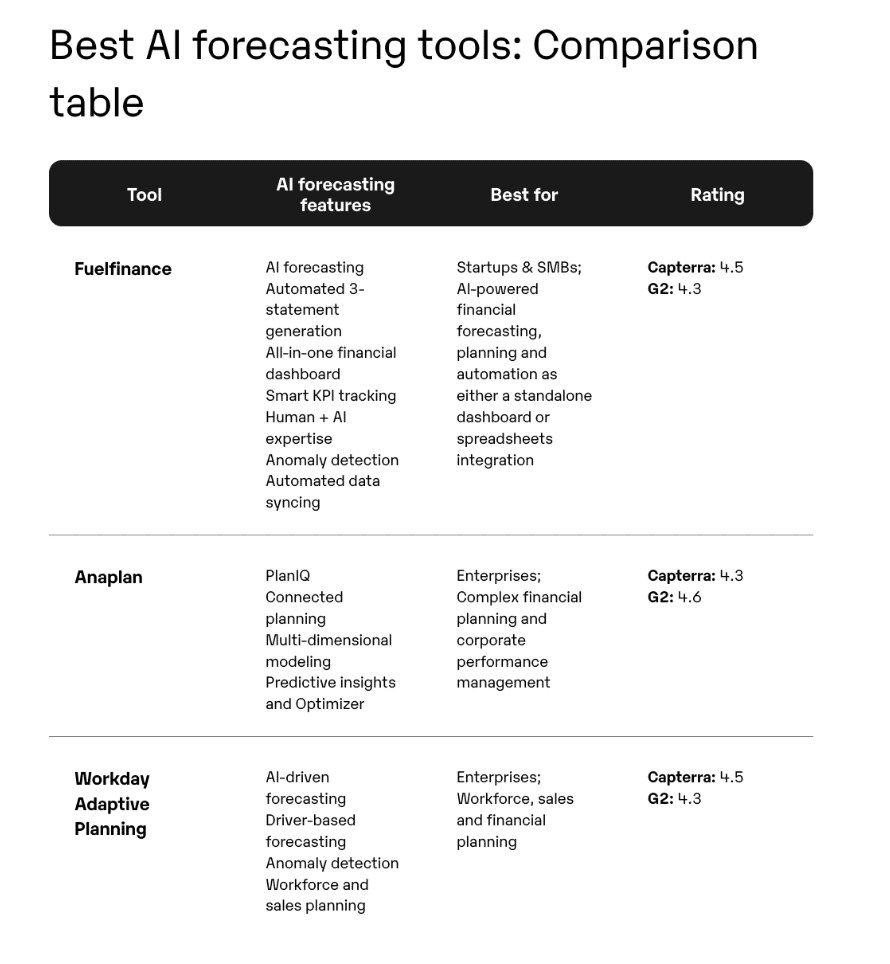
Result: The post ranks for AI forecasting tools in Google AI Overview and gets featured in LLM (AI generated results) for the same keyword. This happened because it answers questions directly and includes strategically structured data.
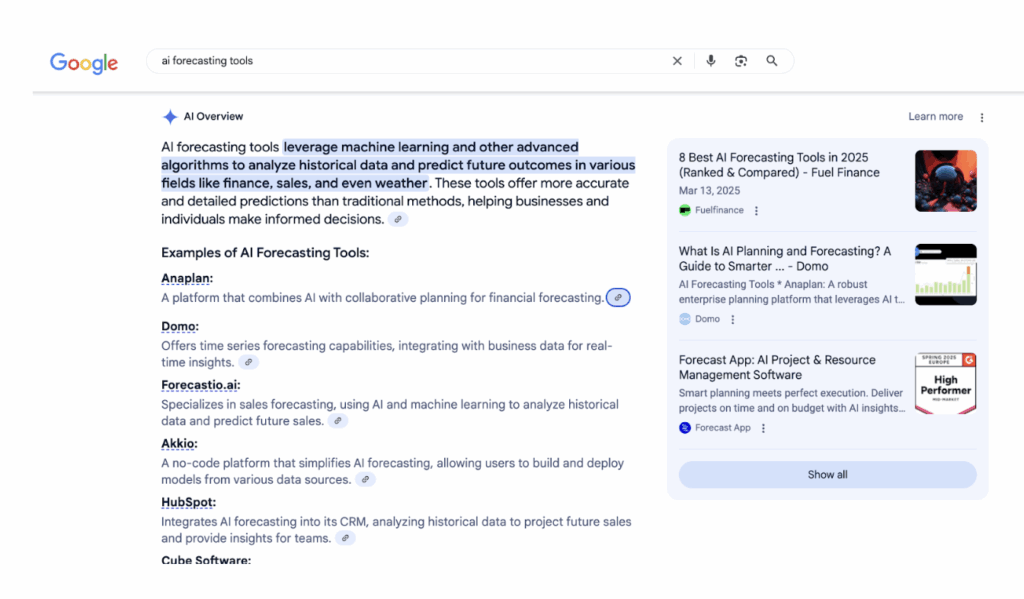
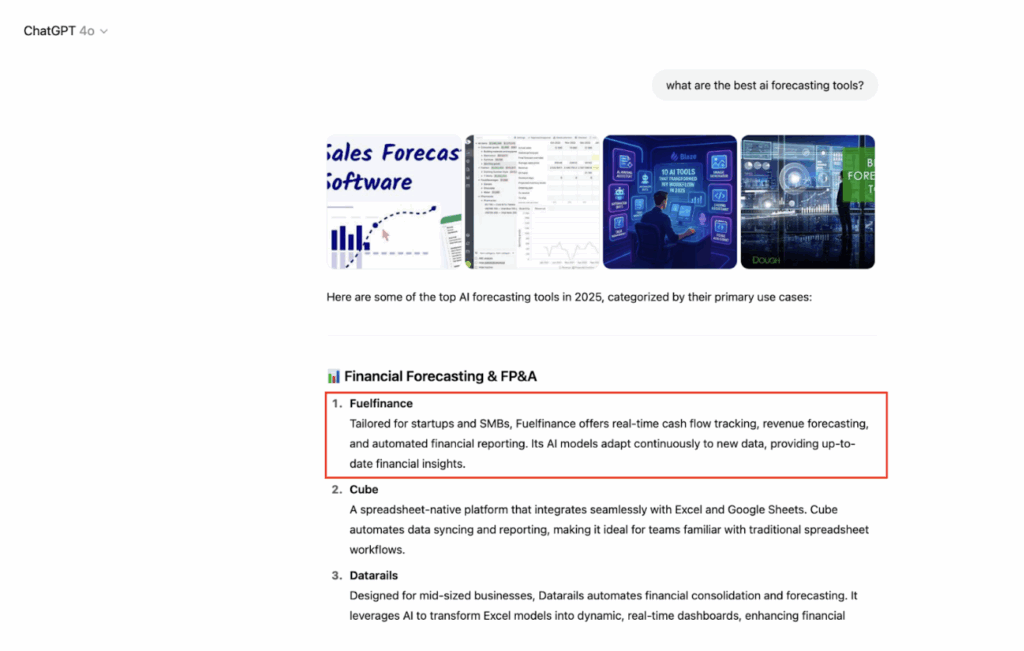
Takeaway: If you’re already writing helpful content, adding schema markup, improving URL structure, and tightening internal linking is like giving your content a megaphone — for AI summaries and for results page visibility.
Read also: Top 6 Generative Engine Optimization (GEO) Agencies of 2025
LLM vs SEO isn’t about picking sides. The best brands are combining both. If you want your SaaS content to show up in AI generated results, it has to make sense to large language models (AI models) and real people.
You’re not writing for robots. You’re writing for real people – AI is just the middle layer now. If your content is vague, bloated, or full of keyword stuffing, it gets ignored. But if it’s well-structured, skimmable, and genuinely helpful, it performs across mobile device and desktop versions, gets picked up in organic search, and may even appear in featured snippets.
Think like a helpful teacher, not a keyword machine. Break things into chunks. Answer real questions. Link related pages so search engines understand your topic depth. Keep both mobile first indexing and technical SEO in mind – first indexing is already here.
Read also: Schema & Structured Data for LLM Visibility: What Actually Helps?
It’s about structuring content so AI models can parse it, understand the semantic meanings, and surface it in AI summaries. It’s different from mobile first indexing, which focused on the mobile version of your site.
Mobile first indexing prioritized mobile device and mobile friendly site performance; AI first focuses on content clarity and technical SEO.
Yes – start with internal linking, schema markup, meta tags, same URL for mobile version and desktop versions, and avoid keyword stuffing.
No – but clean page structure, correct canonical tags, and URL structure help search engines understand your site’s content.
Your homepage and product pages – make them fast (page speed, content delivery network), usable on mobile device, and clear for both human visitors and AI models.
Turn your B2B SaaS content into a magnet for both algorithms and customers. Work with Quoleady
Let us know what you are looking to accomplish.
We’ll give you a clear direction of how to get there.
All consultations are free 🔥
